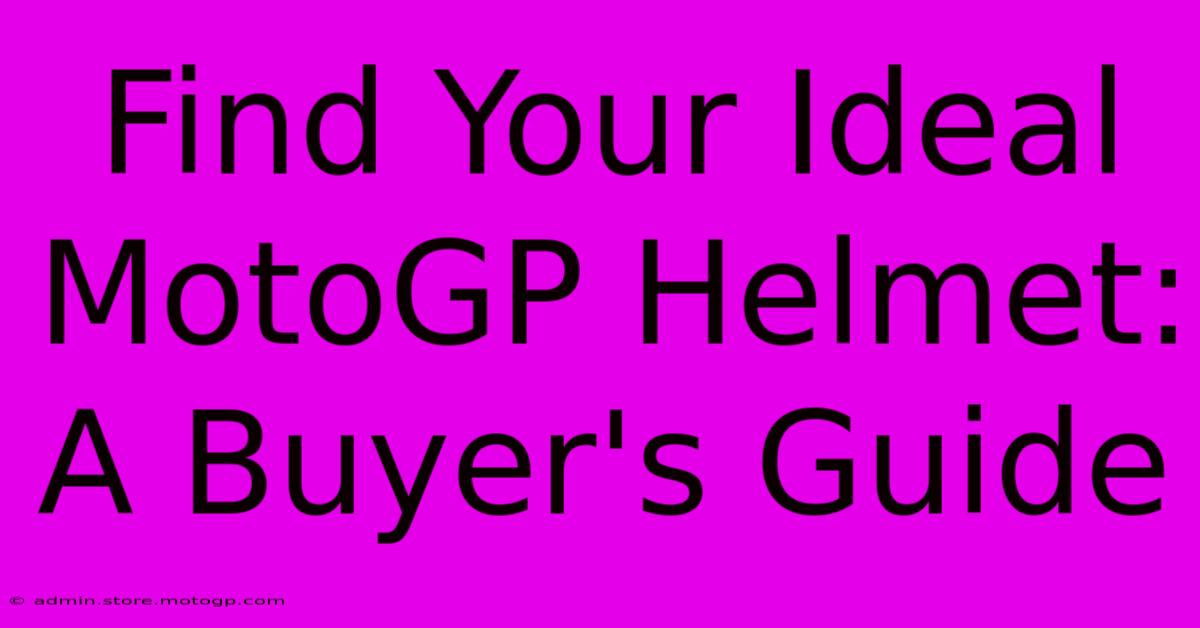Find Your Ideal MotoGP Helmet: A Buyer's Guide

Table of Contents
Find Your Ideal MotoGP Helmet: A Buyer's Guide
Finding the perfect MotoGP helmet can feel overwhelming. With so many brands, models, and features available, knowing where to start is crucial. This comprehensive buyer's guide will help you navigate the options and find the helmet that provides the ultimate combination of safety, comfort, and performance.
Understanding MotoGP Helmet Standards
Before diving into specific features, let's address the most important aspect: safety. MotoGP helmets must meet stringent safety standards, typically exceeding those required for street riding. Look for helmets certified to standards like ECE 22.06 (Europe) or DOT (United States). These certifications ensure the helmet has undergone rigorous testing to meet minimum safety requirements. While some manufacturers boast additional, internal testing, the presence of these certifications is paramount.
Key Safety Features to Consider:
- Shell Material: High-end MotoGP helmets often utilize carbon fiber or aramid fiber composites for their exceptional strength-to-weight ratio. These materials offer superior impact protection compared to less expensive materials like fiberglass.
- Multi-Density EPS Liner: The inner liner, made of Expanded Polystyrene (EPS), absorbs impact energy. A multi-density liner distributes impact forces more effectively, providing better protection in various impact scenarios.
- Emergency Release System: Many MotoGP helmets incorporate cheek pad release systems designed to facilitate helmet removal in emergency situations by medical personnel. This feature can be critical in minimizing secondary injuries.
- Visor Mechanism: Look for visors with robust locking mechanisms and anti-fog and anti-scratch coatings to ensure optimal clarity and visibility during your rides.
Choosing the Right Fit and Features
Once safety is addressed, the focus shifts to comfort and performance. Finding the right fit is paramount. A helmet that's too tight can cause discomfort and impair concentration; one that's too loose compromises safety.
Finding Your Perfect Fit:
- Measure Your Head: Use a soft measuring tape to accurately determine your head circumference. Consult the manufacturer's sizing charts to find the appropriate helmet size.
- Try Before You Buy: If possible, try on various helmets to compare the fit and feel. Consider factors like the shape of your head and the overall comfort of the cheek pads and liner.
- Consider the Liner: The comfort of the liner is crucial for long rides. Look for breathable, moisture-wicking fabrics that help regulate temperature and prevent sweat buildup.
Essential Features to Consider:
- Ventilation System: Effective ventilation is vital for maintaining comfort, especially during intense riding. Look for helmets with multiple vents and channels for optimal airflow.
- Aerodynamics: The aerodynamic design of the helmet plays a crucial role in reducing wind noise and buffeting at high speeds. Consider helmets with integrated spoilers or aerodynamic shaping.
- Communication System: Some helmets are designed to accommodate communication systems for clear communication with other riders or your team. Check for compatibility before purchase if this is a necessity.
Top Brands and Models
Several reputable brands dominate the MotoGP helmet market, each offering unique features and styles. Researching these brands and models will provide valuable insight into various options. However, remember that the best helmet is the one that fits you best and provides the highest level of safety and comfort.
Maintaining Your MotoGP Helmet
Regular maintenance prolongs the lifespan of your helmet and ensures its continued effectiveness. This includes:
- Cleaning: Regularly clean the helmet shell and liner using appropriate cleaning agents and materials.
- Inspection: Periodically inspect the helmet for any signs of damage or wear.
- Replacement: Replace your helmet every few years, or sooner if it's been involved in a crash, regardless of visible damage. The internal structure can be compromised even if the exterior seems unscathed.
Conclusion
Selecting the right MotoGP helmet is a significant investment in your safety and riding experience. By carefully considering the safety standards, fit, features, and maintenance, you can find the ideal helmet that will provide optimal protection and enhance your performance on the track or road. Remember to prioritize safety above all else, and choose a helmet that fits you perfectly and inspires confidence.

Thank you for visiting our website wich cover about Find Your Ideal MotoGP Helmet: A Buyer's Guide. We hope the information provided has been useful to you. Feel free to contact us if you have any questions or need further assistance. See you next time and dont miss to bookmark.
Featured Posts
-
Moto2 2025 The Ultimate Guide To The Standings
Feb 18, 2025
-
Cota Parking Map Your Vip Parking Pass
Feb 18, 2025
-
Experience The Thrill Cota Motorcycle Track Days
Feb 18, 2025
-
Cota Gift Shop Find Something For Everyone
Feb 18, 2025
-
F1 Austin The Ultimate Music And Racing Experience
Feb 18, 2025
